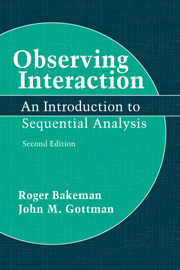Book contents
- Frontmatter
- Contents
- Preface to the second edition
- Preface to the first edition
- 1 Introduction
- 2 Developing a coding scheme
- 3 Recording behavioral sequences
- 4 Assessing observer agreement
- 5 Representing observational data
- 6 Analyzing sequential data: First steps
- 7 Analyzing event sequences
- 8 Issues in sequential analysis
- 9 Analyzing time sequences
- 10 Analyzing cross-classified events
- 11 Epilogue
- Appendix: A Pascal program to compute kappa and weighted kappa
- References
- Index
7 - Analyzing event sequences
Published online by Cambridge University Press: 13 October 2009
- Frontmatter
- Contents
- Preface to the second edition
- Preface to the first edition
- 1 Introduction
- 2 Developing a coding scheme
- 3 Recording behavioral sequences
- 4 Assessing observer agreement
- 5 Representing observational data
- 6 Analyzing sequential data: First steps
- 7 Analyzing event sequences
- 8 Issues in sequential analysis
- 9 Analyzing time sequences
- 10 Analyzing cross-classified events
- 11 Epilogue
- Appendix: A Pascal program to compute kappa and weighted kappa
- References
- Index
Summary
Describing particular sequences: Basic methods
Throughout this chapter, we assume that the reader is interested in event-sequence data. That is, no matter how the data may have been recorded and represented initially, we assume that it is possible to extract event sequences (see section 5.2) from the data, and that the investigator has good reasons for wanting to do so. This means that the data to be analyzed are represented as sequences or chains of coded events (or behavioral states but without time information) and that those events are defined in a way that makes them mutually exclusive and exhaustive. Sometimes the chains will be unbroken, collected all during one uninterrupted observation session. Other times, several sequences may be pooled together for an analysis, either because there were breaks in the observation session or because observation sessions occurred at different times. Data from more than one subject may even be pooled for some analyses (see section 8.4). In all cases, the data to be analyzed consist of chains or sequences of codes.
The codes for event sequences are mutually exclusive and exhaustive, as already noted. In addition, often the logic of the situation does not permit consecutive codes to repeat. For example, when coders are asked to segment the stream of behavior into behavioral states, it follows naturally that two successive states cannot be coded the same say. If they were, they would not be two states, after all, but just one. The restriction that the same code may not follow itself in event sequences occurs relatively often, especially when the events being coded are thought of as states.
- Type
- Chapter
- Information
- Observing InteractionAn Introduction to Sequential Analysis, pp. 100 - 135Publisher: Cambridge University PressPrint publication year: 1997



